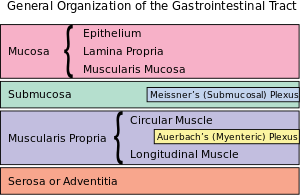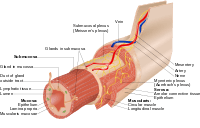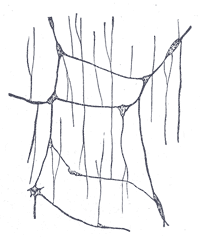Enteric nervous system

 |
| This article is one of a series on the |
| Gastrointestinal wall |
|---|
|
General structure |
|
Specific |
|
Organs |
The enteric nervous system (ENS) or intrinsic nervous system is one of the main divisions of the nervous system and consists of a mesh-like system of neurons that governs the function of the gastrointestinal system.[1] It is now usually referred to as separate from the autonomic nervous system since it has its own independent reflex activity.[2][3]
It is derived from neural crest cells.[4][5]
Structure
The enteric nervous system consists of some 500 million neurons[6] (including the various types of Dogiel cells),[1][7] one two-hundredth of the number of neurons in the brain, five times as many as the one hundred million neurons in the spinal cord,[8] and about 2/3 of the whole nervous system of a cat. The enteric nervous system is embedded in the lining of the gastrointestinal system, beginning in the esophagus and extending down to the anus.[8]
The neurons of the ENS are collected into two types of ganglia: myenteric (Auerbach's) and submucosal (Meissner's) plexuses.[9] Myenteric plexuses are located between the inner and outer layers of the muscularis externa, while submucosal plexuses are located in the submucosa.
Function
The ENS is capable of autonomous functions[10] such as the coordination of reflexes; although it receives considerable innervation from the autonomic nervous system, it can and does operate independently of the brain and the spinal cord.[11] Its study is the focus of neurogastroenterology.
ENS function can be damaged by ischemia.[12] Transplantation, previously described as a theoretical possibility,[13] has been a clinical reality in the United States since 2011 and is regularly performed at some hospitals.[14]
Complexity
The enteric nervous system has been described as a "second brain" for several reasons. The enteric nervous system can operate autonomously. It normally communicates with the central nervous system (CNS) through the parasympathetic (e.g., via the vagus nerve) and sympathetic (e.g., via the prevertebral ganglia) nervous systems. However, vertebrate studies show that when the vagus nerve is severed, the enteric nervous system continues to function.[15]
In vertebrates, the enteric nervous system includes efferent neurons, afferent neurons, and interneurons, all of which make the enteric nervous system capable of carrying reflexes and acting as an integrating center in the absence of CNS input. The sensory neurons report on mechanical and chemical conditions. Through intestinal muscles, the motor neurons control peristalsis and churning of intestinal contents. Other neurons control the secretion of enzymes. The enteric nervous system also makes use of more than 30 neurotransmitters, most of which are identical to the ones found in CNS, such as acetylcholine, dopamine, and serotonin. More than 90% of the body's serotonin lies in the gut, as well as about 50% of the body's dopamine, which is currently being studied to further our understanding of its utility in the brain.[16][17][18]
The enteric nervous system has the capacity to alter its response depending on such factors as bulk and nutrient composition. In addition, ENS contains support cells which are similar to astroglia of the brain and a diffusion barrier around the capillaries surrounding ganglia which is similar to the blood–brain barrier of cerebral blood vessels.[19]
Additional images
-

The myenteric plexus of a rabbit. X 50.
-

The submucosal plexus of a rabbit. X 50.
See also
References
- 1 2 Furness, John Barton (15 April 2008). The Enteric Nervous System. John Wiley & Sons. pp. 35–38. ISBN 978-1-4051-7344-5.
- ↑ Dorland's (2012). Dorland's Illustrated Medical Dictionary (32nd ed.). Elsevier Saunders. p. 1862. ISBN 978-1-4160-6257-8.
- ↑ Pocock, G & Richards, C (2006). Human Physiology The Basis of Medicine (Third ed.). Oxford University Press. p. 63. ISBN 978-0-19-856878-0.
- ↑ Barlow AJ, Wallace AS, Thapar N, Burns AJ (May 2008). "Critical numbers of neural crest cells are required in the pathways from the neural tube to the foregut to ensure complete enteric nervous system formation". Development. 135 (9): 1681–91. doi:10.1242/dev.017418. PMID 18385256.
- ↑ Burns AJ, Thapar N (October 2006). "Advances in ontogeny of the enteric nervous system". Neurogastroenterol. Motil. 18 (10): 876–87. doi:10.1111/j.1365-2982.2006.00806.x. PMID 16961690.
- ↑ Young, Emma. "Gut Instincts: The Secrets of your Second Brain". New Scientist. New Scientist. Retrieved 8 April 2015. (also NeuroScienceStuff, archived 2013-05-04)
- ↑ Gray's page #921
- 1 2 Hall, John E. (2011). "General Principles of Gastrointestinal Function". Guyton and Hal Textbook of Medical Physiology (12th ed.). Saunders Elsevier. p. 755. ISBN 978-1416045748.
- ↑ "The Enteric Nervous System". Retrieved 2008-11-29.
- ↑ "enteric nervous system" at Dorland's Medical Dictionary
- ↑ Gershon & 1998 17.
- ↑ Linhares GK, Martins JL, Fontanezzi F, Patrício Fdos R, Montero EF (2007). "Do lesions of the enteric nervous system occur following intestinal ischemia/reperfusion?". Acta Cir Bras. 22 (2): 120–4. doi:10.1590/S0102-86502007000200008. PMID 17375218.
- ↑ Gershon, MD (April 2007). "Transplanting the enteric nervous system: a step closer to treatment for aganglionosis". Gut. 56 (4): 459–61. doi:10.1136/gut.2006.107748. PMC 1856867
 . PMID 17369379.
. PMID 17369379. - ↑ http://www.medscape.com/viewarticle/436543_2
- ↑ Li,Ying; Owyang,Chung (September 2003). "Musings on the Wanderer: What's New in Our Understanding of Vago-Vagal Reflexes? V. Remodeling of vagus and enteric neural circuitry after vagal injury". American Journal of Physiology. Gastrointestinal and Liver Physiology. 285 (3): G461–9. doi:10.1152/ajpgi.00119.2003.
- ↑ Pasricha, Pankaj Jay. "Stanford Hospital: Brain in the Gut - Your Health".
- ↑ Martinucci I et al. Genetics and pharmacogenetics of aminergic transmitter pathways in functional gastrointestinal disorders. Pharmacogenomics. 2015;16(5):523-39. Review. PMID 25916523
- ↑ Smitka K, et al. The role of "mixed" orexigenic and anorexigenic signals and autoantibodies reacting with appetite-regulating neuropeptides and peptides of the adipose tissue-gut-brain axis: relevance to food intake and nutritional status in patients with anorexia nervosa and bulimia nervosa. Int J Endocrinol. 2013;2013:483145. Review. PMID 24106499 Free full text PMC 3782835
- ↑ Silverthorn, Dee U.(2007)."Human Physiology". Pearson Education, Inc., San Francisco, CA 94111.
Further references
- Grosell M, Farrell A P and Brauner C J (Eds) (2010) Fish Physiology: The Multifunctional Gut of Fish Academic Press. ISBN 9780080961361.
- Gershon M. D. (1999), The Second Brain: A Groundbreaking New Understanding of Nervous Disorders of the Stomach and Intestine, Harper Perennial, ISBN 978-0060930721.
External links
- Physiology: 6/6ch2/s6ch2_29 - Essentials of Human Physiology